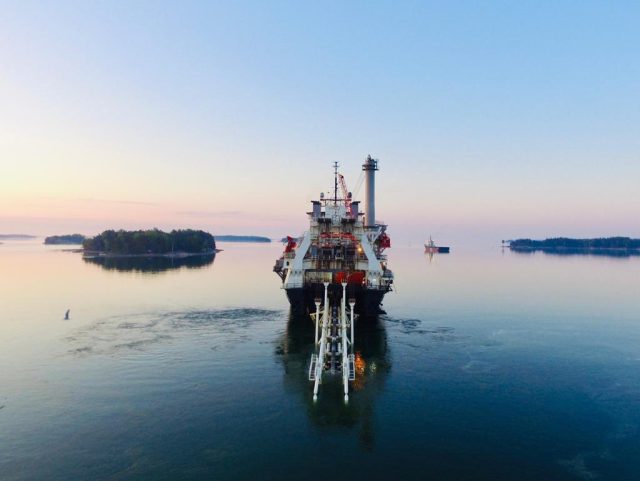
Balticconnector Leak Highlights Need for Stronger Coordination in Protecting Critical Infrastructure
Publication: Eurasia Daily Monitor Volume: 20 Issue: 167
By:

On October 8, the Balticconnector natural gas underwater pipeline running between Finland and Estonia was shut down due to significant damage on the portion of the pipeline within Finland’s exclusive economic zone (EEZ). According to preliminary findings from the Finnish National Bureau of Investigation, the leak was likely caused by a Chinese container ship, the Newnew Polar Bear, dragging its anchor along the seabed (Yle.fi, October 24). Some Finnish officials have argued that this was done intentionally to damage the pipeline. While the Balticconnector is estimated to be offline until at least April 2024 (Gasgrid.fi, October 11), the incident will have a limited impact on regional energy security for the coming winter. The situation, however, renews the debate about whether critical infrastructure in the Baltic Sea region is indeed safe and whether the North Atlantic Treaty Organization (NATO) should consider further protective actions.
Balticconnector is a crucial part of Finland’s energy infrastructure. The 77-kilometer (48-mile) offshore gas pipeline enables bidirectional gas flows between Finland and Estonia with a capacity of up to 2.6 billion cubic meters per annum (bcma). This rate is slightly higher than the overall gas consumption levels in Finland before the COVID-19 pandemic (Energiavirasto.fi, July 12). The interconnector was commissioned in December 2019. In January, a floating regasification unit with a capacity of 5 bcma floating was opened in Inkoo in southern Finland. (Another liquefied natural terminal in Hamina was connected to the grid in 2022 but has very limited capacity.) This development along with the original pipeline have become the only viable alternatives to Finland’s import of Russia gas.
The precise circumstances that led to the pipeline being damaged on October 8 remain unclear, though Finland suspects possible Russian and Chinese involvement. In its first analysis of the photos of the pipeline’s damage and additional traces left on the seabed, the Finnish National Bureau of Investigation suspected that the pipeline had been purposely sabotaged but avoided any immediate accusations (Hs.fi, October 11). Later, Finnish and Estonian media began to speculate on the exact nature of the suspicious activity of Russian oil carrier SGV Flot seemingly in concert with the Chinese-flagged Newnew Polar Bear cargo vessel in the pipeline’s vicinity just before the leak was discovered (Err.ee, October 17).
More recently, additional evidence points to Newnew Polar Bear as the key piece of the puzzle. On October 24, Finnish law enforcement confirmed that it found an anchor near the pipeline, as well as the traces of drag marks leading to the nexus of the damage (Yle.fi, October 24). The Finnish authorities declared that they suspected the anchor was that of the NewNew Polar Bear, as just days after the leak discovered, photos circulated that appeared to show the cargo ship missing an anchor (The Barents Observer, October 26). Marine experts had questioned that such an incident could have happened by accident (Err.ee, October 25). The Finnish Bureau of Investigation claims that the new evidence “clearly indicates that the Newnew Polar Bear is to blame for the damage.”
The situation has been further complicated by evidence that the ultimate owner of the cargo vessel in question is believed to be the Russian-registered company Torgmoll (The Barents Observer, October 26). New permissions given to the Newnew Polar Bear for navigating Russia’s Northern Sea Route were addressed to Torgmoll. Previous permissions had been addressed to Hainan Xin Xin Yang Shipping. Torgmoll has offices in Moscow and Shanghai and claims to be focused on developing China’s Belt and Road Initiative.
The gas transmission operator, Gasgrid Finland, estimates that the repair work will take at least five months (Gasgrid.fi, October 11). Even so, Finland will be able to maintain the security of its energy supply for the coming winter (Gasfrid.fi, October 9). The primary reason for this is the aforementioned natural gas terminal in Inkoo, as its capacity is enough to cover the daily consumption peaks. The project was fast-tracked only after Russia’s invasion of Ukraine in February 2022. If construction of the terminal had not been hastened, then the Finnish population would now be at the mercy of Russia, as the country does not possess adequate natural gas reserves.
The suspected sabotage of the Balticconnector, nevertheless, is being considered in the wider regional security landscape. It took only three days for NATO Secretary-General Jens Stoltenberg to declare that, if the incident proves to be an act of sabotage, the alliance should prepare a “united and determined response” (Nato.int, October 11). The ministers of defense from each NATO member discussed the issue in Brussels on October 12. A few days later, NATO announced that it had increased maritime patrols in the Baltic Sea and flyovers in the regional airspace to better monitor the situation (Err.ee, October 19).
The final findings of the investigation will likely inform NATO’s decision to either provide a military response or deescalate the situation. Meanwhile, NATO members can consider more effective, coordinated methods for protecting and monitoring critical infrastructure in the Baltic Sea region and elsewhere. This includes not only offshore cables and pipelines (e.g., the 10 bcma Baltic Pipe between Denmark and Poland) but also natural gas and crude oil import terminals. NATO already took the first step in this direction when it announced the creation of a Critical Undersea Infrastructure Coordination Cell at NATO headquarters earlier this year (Nato.int, February 15). The recent damage to the Balticconnector pipeline gives greater urgency to the further development of such capabilities within NATO and the expanded cooperation of the alliance’s members in protecting their maritime energy infrastructure.



